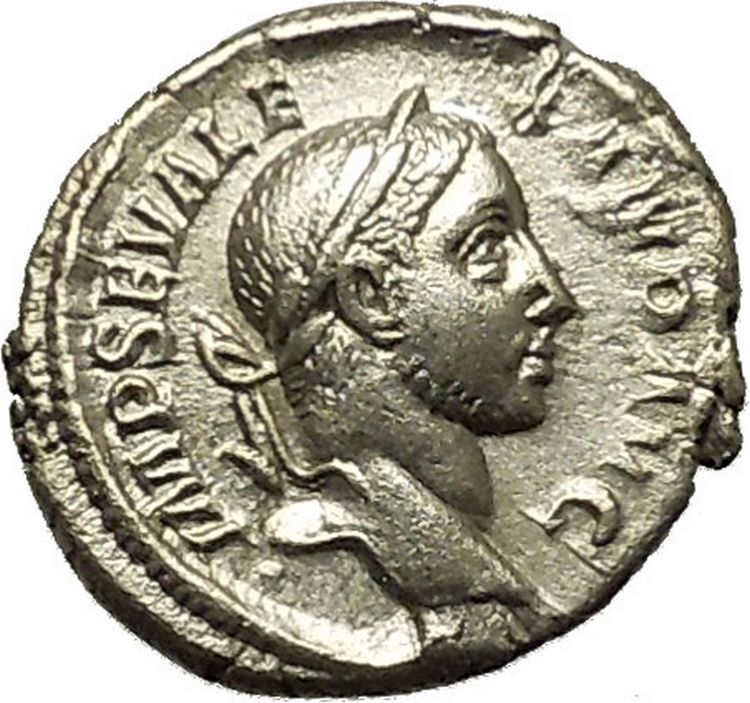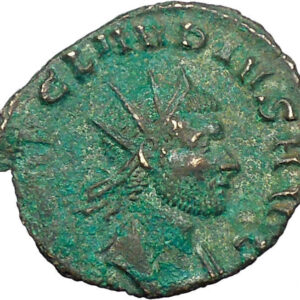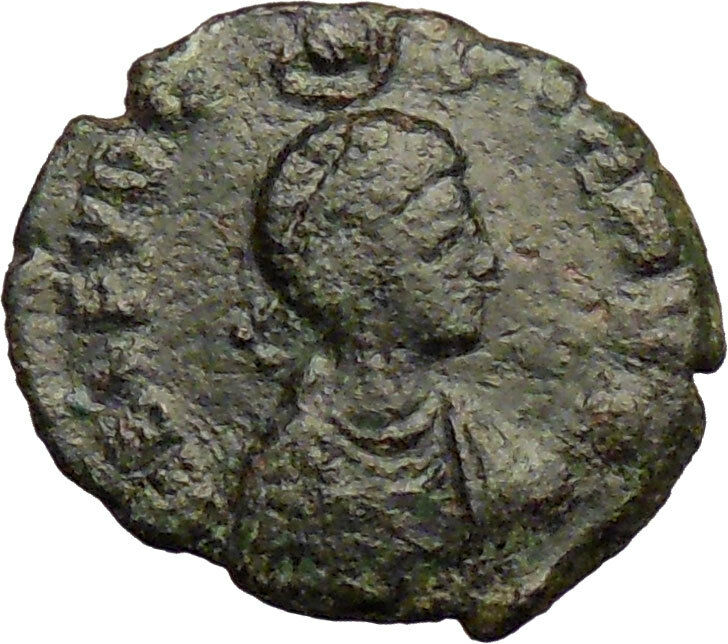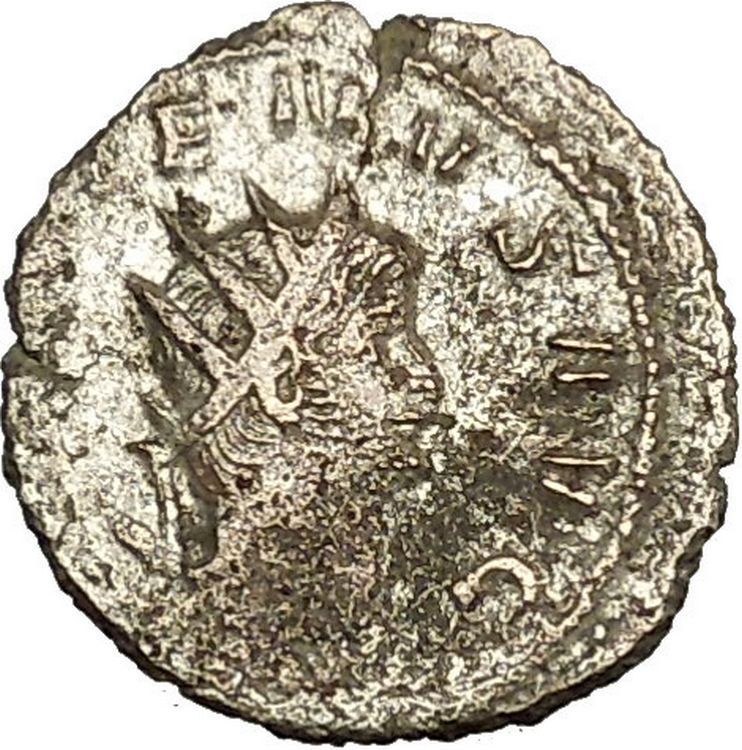|
Julia Mamaea – Roman Empress wife of Emperor Severus
Alexander 222-235 A.D. –
Bronze Sestertius 30mm (20.10 grams) Struck at the mint of Rome 228 A.D.
Reference: RIC 676 (Severus Alexander), C 21
IVLIAMAMAEAAVGVSTA – Diademed, draped bust right.
FELICITASPVBLICA – Felicitas standing left, leaning on column and with legs crossed, holding caduceus.
You are bidding on the exact item pictured,
provided with a Certificate of Authenticity and Lifetime Guarantee of
Authenticity.
Click Here to See all Auction Items for Sale
If you click the above link you will see all auctions I have available for bidding on eBay.
There may be some great deals to be had, so check them out today.
- Greek Low to High & High to low
- Rare Greek, R1, R2, R3, R4
- Roman Republic Page with Easy search by Gens
- Roman Low to High & High to low
- Byzantine Low to High & High to low
- Silver Low to high & High to low
- Gold Low to high & High to low
|
- NGC Low to high & High to low
- NGC Silver Low to high & High to low
- NGC Gold Low to high & High to low
- NGC Greek Low to high & High to low
- NGC Roman Low to high & High to low
- NGC Byzantine Low to high & High to low
|
The caduceus from
Greek
“herald’s staff” is the staff carried by
Hermes
in
Greek mythology
. The same staff was also borne
by heralds in general, for example by
Iris
, the messenger of
Hera. It is a short staff entwined by two
serpents
, sometimes surmounted by wings. In
Roman iconography it was often depicted being carried in the left hand of
Mercury
, the messenger of the gods, guide of
the dead and protector of merchants, shepherds, gamblers, liars, and thieves.
As a symbolic object it represents Hermes (or the Roman Mercury), and by
extension trades, occupations or undertakings associated with the god. In later
Antiquity
the caduceus provided the basis for
the
astrological symbol
representing the
planet Mercury
. Thus, through its use in
astrology
and
alchemy
, it has come to denote the
elemental metal
of the same name.
By extension of its association with Mercury/Hermes, the caduceus is also a
recognized symbol of commerce and negotiation, two realms in which balanced
exchange and reciprocity are recognized as ideals. This association is ancient,
and consistent from the Classical period to modern times. The caduceus is also
used as a symbol representing printing, again by extension of the attributes of
Mercury (in this case associated with writing and eloquence).
The caduceus is sometimes mistakenly used
as a symbol of medicine and/or medical practice
,
especially in
North America
, because of widespread confusion
with the traditional medical symbol, the
rod of Asclepius
, which has only a single snake
and no wings.
The term kerukeion denoted any herald’s staff, not necessarily
associated with Hermes in particular.
Lewis Richard Farnell
(1909) in his study of
the cult of Hermes assumed that the two snakes had simply developed out of
ornaments of the shepherd’s crook used by heralds as their staff. This view has
been rejected by later authors pointing to parallel iconography in the Ancient
Near East. It has been argued that the staff or wand entwined by two snakes was
itself representing a god in the pre-anthropomorphic era. Like the
herm
or
priapus
, it would thus be a predecessor of the
anthropomorphic Hermes of the classical era.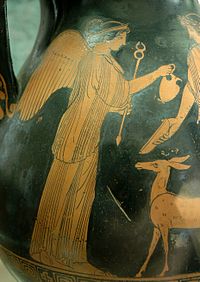
Ancient Near East
William Hayes Ward
(1910) discovered that
symbols similar to the classical caduceus sometimes appeared on
Mesopotamian cylinder seals
. He suggested the
symbol originated some time between 3000 and 4000 BCE, and that it might have
been the source of the Greek caduceus.[10]
A.L. Frothingham incorporated Dr. Ward’s research into his own work, published
in 1916, in which he suggested that the prototype of Hermes was an “Oriental
deity of Babylonian extraction” represented in his earliest form as a snake god.
From this perspective, the caduceus was originally representative of Hermes
himself, in his early form as the Underworld god
Ningishzida
, “messenger” of the “Earth Mother”.
The caduceus is mentioned in passing by
Walter Burkert
[12]
as “really the image of copulating snakes taken over from Ancient Near Eastern
tradition”.
In Egyptian iconography, the
Djed pillar is depicted as containing a snake in a frieze of the
Dendera Temple complex
.
The rod of Moses
and the
brazen serpent
are frequently compared to the
caduceus, especially as Moses is acting as a messenger of God to the
Pharaoh
at the point in the narrative where he
changes his staff into a serpent.[13]
Classical antiquity
Mythology
The
Homeric hymn
to Hermes relates how Hermes
offered his lyre fashioned from a tortoise shell as compensation for the
cattle he stole
from his half brother
Apollo
. Apollo in return gave Hermes the
caduceus as a gesture of friendship. The association with the serpent thus
connects Hermes to Apollo
, as later the serpent was associated
with Asclepius
, the “son of Apollo”. The association
of Apollo with the serpent is a continuation of the older
Indo-European
dragon
-slayer motif.
Wilhelm Heinrich Roscher
(1913) pointed out
that the serpent as an attribute of both Hermes and Asclepius is a variant of
the “pre-historic semi-chthonic serpent hero known at Delphi as
Python
“, who in classical mythology is slain by
Apollo.
One Greek myth of origin
of the caduceus is part of the
story of Tiresias
, who found two snakes copulating and
killed the female with his staff. Tiresias was immediately turned into a woman,
and so remained until he was able to repeat the act with the male snake seven
years later. This staff later came into the possession of the god Hermes, along
with its transformative powers.
Another myth suggests that Hermes (or Mercury) saw two serpents entwined in
mortal combat. Separating them with his wand he brought about peace between
them, and as a result the wand with two serpents came to be seen as a sign of
peace.
In Rome, Livy
refers to the caduceator who
negotiated peace arrangements under the diplomatic protection of the caduceus he
carried.
Iconography
In some vase paintings ancient depictions of the Greek kerukeion are
somewhat different from the commonly seen modern representation. These
representations feature the two snakes atop the staff (or rod), crossed to
create a circle with the heads of the snakes resembling horns. This old graphic
form, with an additional crossbar to the staff, seems to have provided the basis
for the graphical
sign of Mercury
(☿) used in
Greek astrology
from Late Antiquity.
Use in alchemy
and occultism
As the symbol of both the
planet
and the
metal
named for Mercury, the caduceus became an
important symbol in
alchemy
.
The
crucified serpent
was also revived as an
alchemical symbol for
fixatio
, and
John Donne
(Sermons 10:190) uses
“crucified Serpent” as a title of
Jesus Christ
.
Symbol of commerce
A simplified variant of the caduceus is to be found in dictionaries,
indicating a “commercial term” entirely in keeping with the association of
Hermes with commerce. In this form the staff is often depicted with two winglets
attached and the snakes are omitted (or reduced to a small ring in the middle).
The Customs Service of the former
German Democratic Republic
employed the
caduceus, bringing its implied associations with thresholds, translators, and
commerce, in the service medals they issued their staff.
Misuse as symbol
of medicine
It is relatively common, especially in the United States, to find the
caduceus, with its two snakes and wings, used as a symbol of medicine instead of
the correct rod of Asclepius, with only a single snake. This usage is erroneous,
popularised largely as a result of the adoption of the caduceus as its insignia
by the
US Army medical corps
in 1902 at the insistence
of a single officer (though there are conflicting claims as to whether this was
Capt. Frederick P. Reynolds or Col. John R. van Hoff).
The rod of Asclepius is the dominant symbol for professional healthcare
associations in the United States. One survey found that 62% of professional
healthcare associations used the rod of Asclepius as their symbol. The same
survey found that 76% of commercial healthcare organizations used the Caduceus
symbol. The author of the study suggests the difference exists because
professional associations are more likely to have a real understanding of the
two symbols, whereas commercial organizations are more likely to be concerned
with the visual impact a symbol will have in selling their products.
The initial errors leading to its adoption and the continuing confusion it
generates are well known to medical historians. The long-standing and abundantly
attested historical associations of the caduceus with commerce, theft,
deception, and death are considered by many to be inappropriate in a symbol used
by those engaged in the healing arts. This has occasioned significant criticism
of the use of the caduceus in a medical context.
In
ancient Roman culture
, felicitas
(from the Latin
adjective
felix, “fruitful, blessed,
happy, lucky”) is a condition of divinely inspired productivity, blessedness, or
happiness
. Felicitas could encompass
both a woman’s fertility, and a general’s luck or good fortune. The divine
personification of Felicitas was
cultivated
as a goddess. Although felicitas
may be translated as “good luck,” and the goddess Felicitas shares some
characteristics and attributes with
Fortuna
, the two were distinguished in
Roman religion
.Fortuna was unpredictable and
her effects could be negative, as the existence of an altar to Mala Fortuna
(“Bad Luck”) acknowledges.Felicitas, however, always had a positive
significance. She appears with
several epithets that focus on aspects of her divine power.
Felicitas had a temple in Rome as early as the mid-2nd century BC, and during
the Republican era
was honored at two
official festivals
of
Roman state religion
, on July 1 in conjunction
with
Juno
and October 9 as Fausta Felicitas.
Felicitas continued to play an important role in
Imperial cult
, and was frequently portrayed on
coins
as a symbol of the wealth and prosperity
of the Roman Empire
. Her primary attributes are the
caduceus
and
cornucopia
.The English word “felicity” derives
from felicitas.
As virtue or quality

Phallic
relief
with the inscription “Felicitas
dwells here”
In its religious sense, felix means “blessed, under the protection or
favour of the gods; happy.” That which is felix has achieved the
pax divom
, a state of harmony or peace with
the divine world. The word derives from
Indo-European
*dhe(i)l, meaning “happy,
fruitful, productive, full of nourishment.” Related Latin words include
femina, “woman” (a person who provides nourishment or suckles); felo,
“to suckle” in regard to an infant; filius, “son” (a person suckled); and
probably fello, fellare, “to perform
fellatio
“, with an originally non-sexual
meaning of “to suck”. The continued magical association of sexual potency,
increase, and general good fortune in productivity is indicated by the
inscription Hic habitat Felicitas (“Felicitas dwells here”)[8]
on an
apotropaic
relief of a
phallus
at a bakery in
Pompeii
.
In archaic Roman culture, felicitas was a quality expressing the close
bonds between
religion and agriculture
. Felicitas was
at issue when the
suovetaurilia
sacrifice conducted by
Cato the Elder
as
censor
in 184 BC was challenged as having been
unproductive, perhaps for
vitium
, ritual error. In the following
three years Rome had been plagued by a number of ill omens and prodigies (prodigia),
such as severe storms, pestilence, and “showers of blood,” which had required a
series of expiations (supplicationes).
The speech Cato gave to justify himself is known as the Oratio de lustri sui
felicitate, “Speech on the Felicitas of his
Lustrum
“, and survives only as a possible
quotation by a later source. Cato says that a lustrum should be found to
have produced felicitas “if the crops had filled up the storehouses, if
the vintage had been abundant, if the olive oil had flowed deliberately from the
groves”, regardless of whatever else might have occurred. The efficacy of a
ritual might be thus expressed as its felicitas.
The ability to promote felicitas became proof of one’s excellence and
divine favor. Felicitas was simultaneously a divine gift, a quality that
resided within an individual, and a contagious capacity for generating
productive conditions outside oneself: it was a form of “charismatic
authority”. Cicero
lists felicitas as one of the
four virtues of the exemplary general, along with knowledge of
military science
(scientia rei militaris),
virtus
(both “valor” and “virtue”), and
auctoritas
, “authority.” Virtus was
a regular complement to felicitas, which was not thought to attach to
those who were unworthy. Cicero attributed felicitas particularly to
Pompeius Magnus (“Pompey the Great”)
, and
distinguished this felicitas even from the divine good luck enjoyed by
successful generals such as
Fabius Maximus
,
Marcellus
,
Scipio the Younger
and
Marius
.
The sayings (sententiae) of
Publilius Syrus
are often attached to divine
qualities, including Felicitas: “The people’s Felicitas is powerful when she is
merciful” (potens misericors publica est Felicitas).
Epithets
Epithets
of Felicitas include:
Augusta
, the goddess in her association
with the emperor and
Imperial cult
.- Fausta (“Favored, Fortunate”), a state divinity
cultivated
on October 9 in conjunction with
Venus Victrix
and the Genius Populi
Romani (“Genius”
of the Roman People, also known as the Genius Publicus).
- Publica, the “public” Felicitas; that is, the aspect of the
divine force that was concerned with the res publica or commonwealth,
or with the Roman People (Populus Romanus).
- Temporum, the Felicitas “of the times”, a title which emphasize
the felicitas being experienced in current circumstances.
Republic
The
cult
of Felicitas is first recorded in the
mid-2nd century BC, when a
temple
was dedicated to her by
Lucius Licinius Lucullus
, grandfather of the
famous Lucullus
, using booty from his military
campaigns in
Spain
in 151–150 BC. Predecessor to a noted
connoisseur of art, Lucullus obtained and dedicated several statues looted by
Mummius
from
Greece
, including works by
Praxiteles
: the Thespiades, a statue
group of the
Muses
brought from
Thespiae
, and a
Venus
. This Temple of Felicitas was among
several that had a secondary function as art museums, and was recommended by
Cicero
along with the
Fortuna Huiusce
DieiTemple of
for those who enjoyed viewing art but lacked the means to
amass private collections. The temple was located in the
Velabrum
in the
Vicus Tuscus
of the
Campus Martius
, along a route associated with
triumphs
: the axle of
Julius Caesar
‘s triumphal
chariot
in 46 BC is supposed to have broken in
front of it. The temple was destroyed by a fire during the reign of
Claudius
, though the Muses were rescued. It was
not rebuilt at this site.
Sulla identified himself so closely with the quality of felicitcas
that he adopted the
agnomen
(nickname) Felix. His
domination as
dictator
resulted from civil war and
unprecedented military violence within the city of Rome itself, but he
legitimated his authority by claiming that the mere fact of his victory was
proof he was felix and enjoyed the divine favor of the gods. Republican
precedent was to regard a victory as belonging to the Roman people as a whole,
as represented by the
triumphal procession
at which the honored
general submitted public offerings at the
Temple of Jupiter Optimus Maximus
at the
Capitol
, and Sulla thus established an
important theological element for the later authority of the emperor. Although
he established no new temple for Felicitas, he celebrated games (ludi
circenses) in her honor.
On July 1 and October 9, Felicitas received a sacrifice in Capitolio,
on the
Capitoline Hill
, on the latter date as
Fausta Felicitas in conjunction with the
Genius Publicus
(“Public
Genius
“) and
Venus Victrix
. These observances probably took
place at an altar or small shrine (aedicula),
not a separate
temple precinct
. The
Acts of the Arval Brothers
(1st century AD)
prescribe a cow as the sacrifice for Felicitas. Pompey established a shrine for
Felicitas at
his new theater and temple complex
, which used
the steps to the Temple of Venus Victrix as seating. Felicitas was cultivated
with Honor
and Virtue, and she may have shared her
shrine there with
Victory
, as she did in the Imperial era as
Felicitas Caesaris (Caesar’s Felicitas) at
Ameria
. Pompey’s collocation of deities may
have been intended to parallel the Capitoline grouping.
A fourth cult site for Felicitas in Rome had been planned by Caesar, and
possibly begun before his death. Work on the temple was finished by
Lepidus
on the site of the
Curia Hostilia
, which had been restored by
Sulla, destroyed by fire in 52 BC, and demolished by Caesar in 44 BC. This
temple seems not to have existed by the time of
Hadrian
. Its site probably lies under the
church of
Santi Luca e Martina
. v It has been
suggested that an
Ionic capital
and a
tufa wall uncovered at the site are the only known remains of the
temple.
Felicitas was a
watchword
used by Julius Caesar’s troops at the
Battle of Thapsus
, the names of deities and
divine personifications being often recorded for this purpose in the late
Republic.
Felicitas Iulia
(“Julian Felicitas”) was
the name of a
colony
in
Roman Spain
that was refounded under Caesar and
known also as Olisipo
, present-day
Lisbon
, Portugal.
During the Republic, only divine personifications known to have had a temple
or public altar were featured on coins, among them Felicitas. On the only extant
Republican coin type, Felicitas appears as a bust and wearing a
diadem
.
Empire

Felicitas Temporum represented by a pair of cornucopiae on a
denarius
(193-194 AD) issued under
Pescennius Niger
A calendar from Cumae
records that a
supplicatio
was celebrated on April 16 for
the Felicitas of the Empire, in honor of the day
Augustus
was first acclaimed
imperator
. In extant Roman coinage,
Felicitas appears with a
caduceus
only during the Imperial period. The
earliest known example is Felicitas Publica on a
dupondius
issued under
Galba
. Felicitas Temporum (“Prosperity
of the Times”), reflecting a
Golden Age
ideology, was among the innovative
virtues that began to appear during the reigns of
Trajan
and
Antoninus Pius
.
Septimius Severus
, whose reign followed the
exceedingly brief tenure of
Pertinax
and unsatisfactory conditions under
Commodus
, used coinage to express his efforts
toward restoring the
Pax Romana
, with themes such as Felicitas
Temporum and Felicitas Saeculi, “Prosperity of the Age” (saeculum),
prevalent in the years 200 to 202. Some Imperial coins use these phrases with
images of women and children in the emperor’s family.
When the Empire came under Christian rule, the personified virtues that had
been cultivated as deities could be treated as abstract concepts. Felicitas
Perpetua Saeculi (“Perpetual Blessedness of the Age”) appears on a coin
issued under
Constantine
, the first emperor to convert to
Christianity.
Julia
Avita Mamaea (14 or 29 August after 180–235) was the second daughter of
Julia
Maesa
, a powerful
 Roman woman of Syrian Roman woman of Syrian
Arab
origin and Syrian noble
Julius Avitus
. She was a niece of empress
Julia
Domna
and
emperor
Septimius Severus
and sister of
Julia Soaemias
. She was born and raised in
Emesa
(modern
Homs
, Syria
).
Julia’s first husband was a former consul (whose name is unknown) who died.
Julia married as her second husband Syrian
Promagistrate
Marcus Julius Gessius Marcianus
. Julia bore Marcianus two children, a
daughter called Theoclia (little is known of her) and a son, Marcus Julius
Gessius Bassianus Alexianus, later emperor
Alexander Severus
. Unlike her sister, Julia Mamaea was reported to be a
virtuous woman, never involved in scandals.
As a member of the Imperial Roman family, she watched closely the death of
her cousin Caracalla
and the ascent to power of her nephew
Elagabalus
,
the oldest grandson of Julia Maesa and her choice to the throne. Eventually
Elagabalus and his mother Julia Soaemias proved incompetent rulers and favour
fell on Alexander, Julia’s son. He became emperor in 222, following Elagabalus’
murder by the
Praetorian Guard
. Julia and her mother became regents in the name of
Alexander, then 14 years old. Upon adulthood, Alexander confirmed his esteem for
his mother and named her consors imperii (imperial consort). It was in
this condition that she accompanied her son in his campaigns: a custom started
with Julia Domna
. Thus she travelled to the East, for the campaign against
Parthia
and
to the Germania provinces. Julia Mamaea was with Alexander in Moguntiacum
(modern Mainz
),
capital of
Germania Superior
, when he was assassinated by his troops. She suffered the
same fate.
The sestertius, or sesterce, (pl. sestertii) was an
ancient Roman
coin. During the
Roman Republic
it was a small,
silver
coin issued only on rare occasions.
During the
Roman Empire
it was a large
brass
coin.

Helmed Roma head right, IIS behind
Dioscuri
riding right, ROMA in linear frame
below. RSC4, C44/7, BMC13.
The name sestertius (originally semis-tertius) means “2 ½”, the
coin’s original value in
asses
, and is a combination of semis
“half” and tertius “third”, that is, “the third half” (0 ½ being the
first half and 1 ½ the second half) or “half the third” (two units
plus half the third unit, or halfway between the second unit and
the third). Parallel constructions exist in
Danish
with halvanden (1 ½),
halvtredje (2 ½) and halvfjerde (3 ½). The form sesterce,
derived from
French
, was once used in preference to the
Latin form, but is now considered old-fashioned.
It is abbreviated as (originally IIS).

Example of a detailed portrait of
Hadrian
117 to 138
History
The sestertius was introduced c. 211 BC as a small
silver
coin valued at one-quarter of a
denarius
(and thus one hundredth of an
aureus
). A silver denarius was supposed to
weigh about 4.5 grams, valued at ten grams, with the silver sestertius valued at
two and one-half grams. In practice, the coins were usually underweight.
When the denarius was retariffed to sixteen asses (due to the gradual
reduction in the size of bronze denominations), the sestertius was accordingly
revalued to four asses, still equal to one quarter of a denarius. It was
produced sporadically, far less often than the denarius, through 44 BC.

Hostilian
under
Trajan Decius
250 AD
In or about 23 BC, with the coinage reform of
Augustus
, the denomination of sestertius was
introduced as the large brass denomination. Augustus tariffed the value of the
sestertius as 1/100 Aureus
. The sestertius was produced as the
largest brass
denomination until the late 3rd century
AD. Most were struck in the mint of
Rome but from AD 64 during the reign of
Nero (AD 54–68) and
Vespasian
(AD 69–79), the mint of
Lyon (Lugdunum), supplemented production. Lyon sestertii can
be recognised by a small globe, or legend stop), beneath the bust.[citation
needed]
The brass sestertius typically weighs in the region of 25 to 28 grammes, is
around 32–34 mm in diameter and about 4 mm thick. The distinction between
bronze
and brass was important to the Romans.
Their name for brass
was
orichalcum
, a word sometimes also spelled
aurichalcum (echoing the word for a gold coin, aureus), meaning
‘gold-copper’, because of its shiny, gold-like appearance when the coins were
newly struck (see, for example
Pliny the Elder
in his Natural History
Book 34.4).
Orichalcum
was considered, by weight, to be
worth about double that of bronze. This is why the half-sestertius, the
dupondius
, was around the same size and weight
as the bronze as, but was worth two asses.
Sestertii continued to be struck until the late 3rd century, although there
was a marked deterioration in the quality of the metal used and the striking
even though portraiture remained strong. Later emperors increasingly relied on
melting down older sestertii, a process which led to the zinc component being
gradually lost as it burned off in the high temperatures needed to melt copper (Zinc
melts at 419 °C, Copper
at 1085 °C). The shortfall was made up
with bronze and even lead. Later sestertii tend to be darker in appearance as a
result and are made from more crudely prepared blanks (see the
Hostilian
coin on this page).
The gradual impact of
inflation
caused by
debasement
of the silver currency meant that
the purchasing power of the sestertius and smaller denominations like the
dupondius and as was steadily reduced. In the 1st century AD, everyday small
change was dominated by the dupondius and as, but in the 2nd century, as
inflation bit, the sestertius became the dominant small change. In the 3rd
century silver coinage contained less and less silver, and more and more copper
or bronze. By the 260s and 270s the main unit was the double-denarius, the
antoninianus
, but by then these small coins
were almost all bronze. Although these coins were theoretically worth eight
sestertii, the average sestertius was worth far more in plain terms of the metal
they contained.
Some of the last sestertii were struck by
Aurelian
(270–275 AD). During the end of its
issue, when sestertii were reduced in size and quality, the
double sestertius
was issued first by
Trajan Decius
(249–251 AD) and later in large
quantity by the ruler of a breakaway regime in the West called
Postumus
(259–268 AD), who often used worn old
sestertii to
overstrike
his image and legends on. The double
sestertius was distinguished from the sestertius by the
radiate crown
worn by the emperor, a device
used to distinguish the dupondius from the as and the antoninianus from the
denarius.
Eventually, the inevitable happened. Many sestertii were withdrawn by the
state and by forgers, to melt down to make the debased antoninianus, which made
inflation worse. In the coinage reforms of the 4th century, the sestertius
played no part and passed into history.
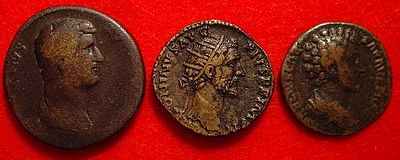
Sestertius of
Hadrian
, dupondius of
Antoninus Pius
, and as of
Marcus Aurelius
As a unit of account
The sestertius was also used as a standard unit of account, represented on
inscriptions with the monogram HS. Large values were recorded in terms of
sestertium milia, thousands of sestertii, with the milia often
omitted and implied. The hyper-wealthy general and politician of the late Roman
Republic,
Crassus
(who fought in the war to defeat
Spartacus
), was said by Pliny the Elder to have
had ‘estates worth 200 million sesterces’.
A loaf of bread cost roughly half a sestertius, and a
sextarius
(~0.5 liter) of
wine anywhere from less than half to more than 1 sestertius. One
modius
(6.67 kg) of
wheat
in 79 AD
Pompeii
cost 7 sestertii, of
rye
3 sestertii, a bucket 2 sestertii, a tunic 15 sestertii, a donkey 500 sestertii.
Records from Pompeii
show a
slave
being sold at auction for 6,252 sestertii.
A writing tablet from
Londinium
(Roman
London
), dated to c. 75–125 AD, records the
sale of a Gallic
slave girl called Fortunata for 600
denarii, equal to 2,400 sestertii, to a man called Vegetus. It is difficult to
make any comparisons with modern coinage or prices, but for most of the 1st
century AD the ordinary
legionary
was paid 900 sestertii per annum,
rising to 1,200 under
Domitian
(81-96 AD), the equivalent of 3.3
sestertii per day. Half of this was deducted for living costs, leaving the
soldier (if he was lucky enough actually to get paid) with about 1.65 sestertii
per day.
Perhaps a more useful comparison is a modern salary: in 2010 a private
soldier in the US Army (grade E-2) earned about $20,000 a year.
Numismatic value

A sestertius of
Nero
, struck at
Rome
in 64 AD. The reverse depicts
the emperor on horseback with a companion. The legend reads DECVRSIO,
‘a military exercise’. Diameter 35mm
Sestertii are highly valued by
numismatists
, since their large size gave
caelatores (engravers) a large area in which to produce detailed portraits
and reverse types. The most celebrated are those produced for
Nero (54-68 AD) between the years 64 and 68 AD, created by some of
the most accomplished coin engravers in history. The brutally realistic
portraits of this emperor, and the elegant reverse designs, greatly impressed
and influenced the artists of the
Renaissance
. The series issued by
Hadrian
(117-138 AD), recording his travels
around the Roman Empire, brilliantly depicts the Empire at its height, and
included the first representation on a coin of the figure of
Britannia
; it was revived by
Charles II
, and was a feature of
United Kingdom
coinage until the
2008 redesign
.
Very high quality examples can sell for over a million
dollars
at auction as of 2008, but the coins
were produced in such colossal abundance that millions survive.
|










 Roman woman of Syrian
Roman woman of Syrian




